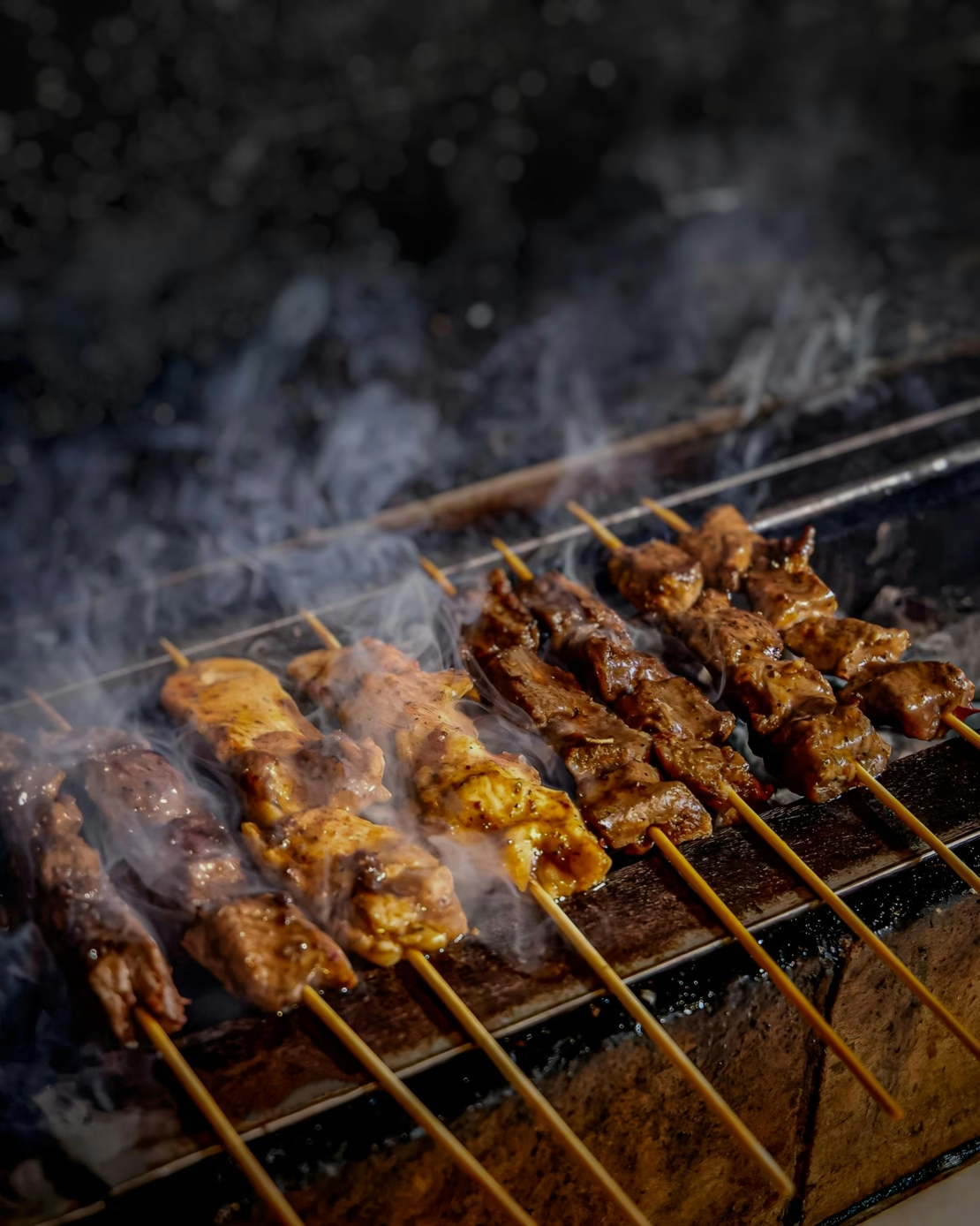Chicken Satay is a beloved dish originating from Indonesia, but it is also widely enjoyed across Malaysia and other Southeast Asian countries. Known for its smoky flavor, tender chicken, and rich peanut sauce, Chicken Satay is a street food favorite and a staple at celebrations, festivals, and barbecues. This skewered delight has earned global recognition for its delicious combination of grilled meat and flavorful dipping sauce.
In this detailed guide, we’ll explore everything you need to know about making Chicken Satay—from the ingredients and cooking steps to serving suggestions, variations, and a rich history. Let’s dive into the world of this mouthwatering dish!
Table of Contents
Ingredients
For the Marinade:
- 500g (1 lb) boneless, skinless chicken thighs (cut into bite-sized pieces)
- 2 tablespoons soy sauce
- 1 tablespoon fish sauce
- 1 tablespoon palm sugar (or brown sugar)
- 1 tablespoon vegetable oil
- 2 cloves garlic, minced
- 1 small shallot, finely chopped
- 1 tablespoon fresh lime juice
- 1 teaspoon ground coriander
- 1 teaspoon turmeric powder
- 1/2 teaspoon ground cumin
- 1/2 teaspoon ground white pepper
For the Peanut Sauce (Satay Sauce):
- 1/2 cup unsweetened peanut butter
- 1/4 cup coconut milk
- 1 tablespoon soy sauce
- 1 tablespoon brown sugar or palm sugar
- 1 tablespoon lime juice
- 1 tablespoon fish sauce
- 1/2 teaspoon chili flakes (optional for heat)
- 1/2 teaspoon ground turmeric
- 1/4 cup water (to adjust consistency)
- Salt to taste
For the Skewers:
- 10–12 bamboo skewers (soaked in water for 30 minutes to prevent burning)
Serves
This recipe serves 4 people as a main dish, with rice or salad as an accompaniment.
Step-by-Step Instructions
Step 1: Prepare the Chicken
- Cut the Chicken: Slice the boneless chicken thighs into bite-sized cubes. Chicken thighs are ideal for satay as they remain tender and juicy after grilling.
- Make the Marinade: In a large bowl, combine soy sauce, fish sauce, palm sugar, vegetable oil, garlic, shallot, lime juice, ground coriander, turmeric, cumin, and white pepper. Stir until the sugar dissolves and the marinade is smooth.
- Marinate the Chicken: Add the chicken pieces to the marinade and toss until well-coated. Cover and refrigerate for at least 1–2 hours, or preferably overnight, to allow the flavors to penetrate the meat.
Step 2: Prepare the Peanut Sauce
- In a small saucepan, combine peanut butter, coconut milk, soy sauce, brown sugar, lime juice, fish sauce, chili flakes (optional), and ground turmeric.
- Heat the mixture over low-medium heat, stirring constantly, until the sauce is smooth and slightly thickened. Adjust the consistency by adding a little water if necessary.
- Once the sauce reaches your desired consistency, remove it from the heat and let it cool slightly. Taste and adjust seasoning as needed.
Step 3: Skewer the Chicken
- Thread the marinated chicken pieces onto the soaked bamboo skewers, ensuring that they are evenly spaced. Each skewer should have around 5–6 pieces of chicken.
- Preheat your grill or griddle pan to medium-high heat.
Step 4: Grill the Chicken
- Place the skewers on the grill and cook for about 5–7 minutes per side, or until the chicken is cooked through with a nice char on the outside. The internal temperature should reach 165°F (75°C).
- During grilling, baste the chicken with any remaining marinade for extra flavor. However, ensure that you stop basting in the final minutes to prevent any risk of cross-contamination from raw chicken.
Step 5: Serve
- Once the chicken is fully cooked, remove the skewers from the grill and let them rest for a few minutes.
- Serve the Chicken Satay with the peanut sauce on the side for dipping.
- Pair with steamed jasmine rice, a simple cucumber salad, or nasi lemak for a complete meal.
Serving Suggestions
- With Rice: Serve the satay with fragrant jasmine rice or coconut rice to balance out the richness of the peanut sauce.
- As a Snack: Serve it as a party appetizer or street food-style snack for guests to enjoy while mingling.
- With Cucumber and Pickles: A fresh cucumber salad with vinegar, sugar, and chili complements the richness of the chicken and peanut sauce.
- Garnish with fresh herbs: Top with freshly chopped cilantro, mint, or basil for an aromatic finish.
Tips for Perfect Chicken Satay
- Use chicken thighs: Chicken thighs stay moist and tender when grilled, making them perfect for satay.
- Marinate overnight: For the best flavor, marinate the chicken for overnight to allow the spices to fully penetrate the meat.
- Grill over medium heat: Grilling over too high a heat can burn the chicken, so make sure to use medium-high heat for even cooking.
- Keep the sauce warm: If making the peanut sauce in advance, warm it gently on the stove before serving.
- Don’t overcook the chicken: Overcooking can dry out the chicken, so keep an eye on it and use a meat thermometer to ensure it’s cooked properly.
Healthier Alternatives
- Use skinless chicken breasts: For a leaner version, substitute the thighs with boneless, skinless chicken breasts. The meat will still be tender, but slightly less juicy.
- Reduce the sugar: You can cut back on the sugar in both the marinade and the peanut sauce to make the dish healthier.
- Use almond or cashew butter: For a variation, try using almond butter or cashew butter in the peanut sauce for a different flavor profile.
- Lower-sodium soy sauce: Opt for low-sodium soy sauce to reduce the overall salt content in the dish.
Creative Variations
- Vegetarian Satay: Substitute the chicken with tofu, mushrooms, or tempeh for a plant-based version of satay.
- Spicy Satay: Add extra chili flakes or fresh Thai bird’s eye chilies to the marinade and peanut sauce for an extra punch of heat.
- Pineapple Satay: Marinate pieces of fresh pineapple alongside the chicken for a sweet and tangy flavor that pairs wonderfully with the peanut sauce.
- Satay with Shrimp: Swap the chicken for shrimp for a lighter version of satay. Be sure to adjust the grilling time as shrimp cook much faster.
Common Mistakes to Avoid
- Using too much sugar: It’s easy to over-sweeten the peanut sauce. Taste as you go and adjust the sweetness to your liking.
- Skipping the marination step: Marination is essential for infusing the chicken with flavor. Don’t rush it—let the chicken marinate for at least a couple of hours.
- Overcrowding the grill: Avoid crowding the skewers on the grill. This can lead to uneven cooking and make it harder to achieve the desired char.
- Not soaking the bamboo skewers: Soaking the skewers in water for at least 30 minutes prevents them from burning on the grill.
History of Chicken Satay
Satay is believed to have originated in Indonesia, where it is a central part of the culinary landscape. The dish has roots in the Indian subcontinent, where skewered meats have been a part of the culinary tradition for centuries. Satay likely made its way to Indonesia through trade routes, evolving into the beloved dish it is today.
The dish became incredibly popular in Indonesia and Malaysia, where it became a street food staple, often sold by vendors at local markets. Over time, satay has adapted to regional flavors, with different countries adding their own touches to the marinade and sauce.
In Indonesia, satay is often served with a variety of meats such as chicken, beef, lamb, and even goat, all grilled to perfection and served with a rich peanut sauce. Chicken satay, however, is by far the most common and beloved version of the dish.
Today, Chicken Satay is enjoyed around the world, both at home and in restaurants. It has become a symbol of Southeast Asian cuisine, with its rich flavors and irresistible aroma making it a favorite at barbecues, parties, and celebrations.
FAQs About Chicken Satay
1. Can I use chicken breasts instead of thighs?
Yes, you can substitute chicken breasts for thighs, but thighs remain the best choice for their tenderness and juiciness.
2. How do I make the peanut sauce thicker?
You can thicken the peanut sauce by adding more peanut butter or reducing it over low heat.
3. Can I use other types of meat for satay?
Yes! Satay can be made with various meats like beef, lamb, or shrimp. Each type of meat offers a unique flavor when paired with the peanut sauce.
4. Can I make the peanut sauce ahead of time?
Yes, you can make the peanut sauce in advance. Store it in the refrigerator for up to 3–4 days and reheat before serving.
5. Can I grill satay on a stovetop grill pan?
Absolutely! A stovetop grill pan works well for satay if you don’t have access to an outdoor grill.
6. How long should I marinate the chicken?
Marinate the chicken for at least 1–2 hours, but for the best flavor, marinate overnight.
7. What’s the best way to serve Chicken Satay?
Serve it with jasmine rice, a cucumber salad, or nasi lemak for a well-rounded meal.
8. Can I make Chicken Satay on skewers other than bamboo?
Yes, you can use metal skewers or wooden skewers, as long as you soak the wood in water to prevent burning.
9. Is Chicken Satay gluten-free?
Chicken Satay can be made gluten-free by using gluten-free soy sauce.
10. Can I freeze marinated chicken for satay?
Yes, you can freeze the marinated chicken for up to 3 months. Thaw it before grilling.
Chicken Satay (Indonesia/Malaysia) is a dish that brings together bold flavors, tender chicken, and a rich, creamy peanut sauce. Whether you’re enjoying it at a local street food stall or making it at home, this dish offers a delightful combination of textures and tastes that are sure to impress.
With this step-by-step guide, you now have everything you need to create the perfect satay at home. So fire up the grill, marinate your chicken, and treat yourself and your guests to a delicious taste of Southeast Asia!


